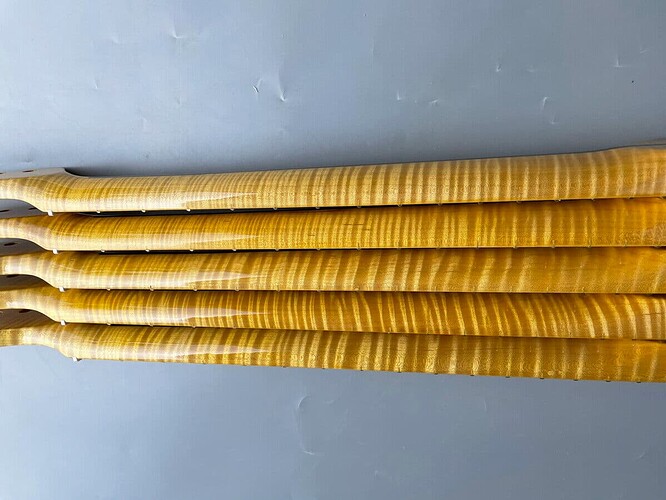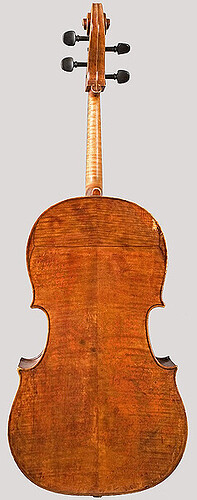Yeah a Dremel and some wire, you got this
So, a little recap so far:
- there are different treatments and terms that might get confused - torrefaction, thermal treatment, roasting, flame roasting, …
- there seem to be some advantages to treating the wood with these techniques, but there is also still a lot of controversy about how grounded in science and engineering this is (should be a perfect topic for some of those YouTubers out there!!)
- beyond any real or perceived improvement to the characteristics of the woods, there is undeniably an aesthetic appeal to many. (Personally, I am with @John_E here: I am not seeking them out, but wouldn’t shun a bass based on that if it ticks all the other boxes)
- I am still unsure why they are virtually everywhere right now (cost perhaps? cheaper woods that get more “usable”!? or really just a visual fad!?), and it is as if you need to work harder to find non-flamed necks (maybe a slight exaggeration, but looking at recent newsletters from big stores, I can’t shake the feeling that literally every maker is offering them now).
Anyhoo, thanks for chiming in 
Flamed refers to the grain pattern in the wood, e.g., tiger flamed Maple versus plain Maple.
Roasted = torrefied. Same process; different names
Wood with a flamed grain pattern can be roasted, but so can plain wood. Flamed and roasted are two different things.
Been used in woodworking a long time. Characteristics well documented.
Caramelized is another synonym
I don’t see any controversy with it, other than bassists like to discuss things a lot. It’s stable and reacts to the environment less, that’s a fact. It’s harder and stronger, but more brittle. But I take the strength personally with a grain of salt. If you rely on the tensile strength of your neck you’re abusing your bass.
It reacts less because there’s less moisture in the wood to expand and contract. Basically you’re aging the wood
It’s trendy.
Like a Kardasian.
Give it time, they will both go away.
Roasted wood has been a legitimate thing in custom acoustic guitar lutherie for a very long time.
Woods naturally dry out over years, and vintage acoustics develop tonal characteristics that new builds can’t match. I have a vintage parlor guitar that is over 110 years-old. It is completely dried out, light as a feather and crazy loud and resonant for such a tiny instrument.
Electric instrument luthiers have known about roasting for a long time. Some custom buiders roast body blanks, but more use roasted necks for stability and to simulate the characteristics of played-in vintage necks.
Roasted wood is also lighter. That’s been left out.
I don’t see it going away. Flame maple yes, that’s trendy. Purely aesthetic.
But roasted necks have some practical advantages and that’s always in
This is what I was saying about vintage (or roasted) wood being dried out. Removing the water content definitely makes the wood lighter.
I have a vintage parlor guitar that is over 110 years-old. It is completely dried out, light as a feather
Flamed maple is also a time-honored influence of acoustic instruments that’s been adopted by some electric builders. I don’t see it as trendy, but as an esthetic wood upgrade.
As an example of historic precedent, here is a Bass Viola da Gamba Stradivarius circa 1730 - converted into a violoncello in 1831. Note the use of flamed wood throughout.

Thanks all for providing more perspective about this age-old technique and the reasons behind using this approach for instrument making.
Still, the two central questions remain:
- why now (for electric basses)? Why not 10, 20 or 30 years ago?
- why so many all of a sudden?
Hm??
(Recent) Fad ![]()
I don’t know, @joergkutter, but it’s likely to stand out.
Classical instrument luthiers have sought out seasoned (dry) wood for their instruments for centuries. The reasons were for the woods’ resonance and stability.
When solid body electric instruments came along, the only thing they shared in common with acoustic instruments was neck construction and materials. But Fender was also a factory operation, and it cranked out tons of product using any wood available.
In the high-end acoustic guitar world, flamed and exotic woods are offered and spec’ed by luthiers for custom builds. This has gone on for decades.
Many custom bass luthiers, boutique shops, and even factory custom shops offer exotic woods to customers at premium prices.
Conversely, Warmoth and other parts vendors offer maple necks in plain, flamed and/or roasted versions.
And Sire offers roasted maple necks on their quality builds at bargain price points.
Why and/or why now?
Because there’s a ton of competition in the solid body electric market, and manufacturers need to attract customers in a very crowded, competitive market.
Yep, good point! Even Harley Benton have it in their range of models.
Once again, same as the Kardasians. ![]()
They feel amazing to play on, and that’s good enough for me






